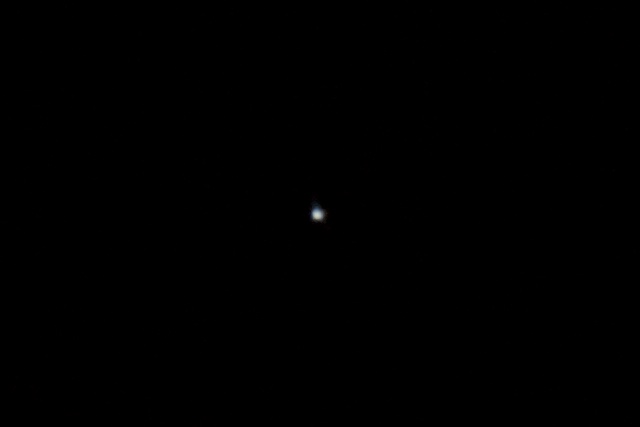
Uranus, Neptune, Jupiter imaging, iPhone M42, & more Spectroscopy
Posted: 31 October 2011
Cassiopeia Observatory was opened at 2036 MST, 64°F. The sky was clear but there were some clouds low in the southwestern sky. First, I viewed Neptune and then Uranus. I then set up for D7000 prime focus imaging with the 8" LX200-ACF. Seeing was not very good; the planets were dancing around quite a bit, making good imaging difficult. I had to use the "Hat Trick" method to image both planets. These are the best images I could get this night. First is Neptune, ISO 5000:

This is Uranus, ISO 2500:

I then slewed to Jupiter. Seeing was a little better in Jupiter's direction. This is a 1/400sec, ISO 2500, exposure. The Great Red Spot is faintly visible in the South Equatorial Belt, right of center.

The three planet images above all cropped to the same scale and north is up.
I then captured this image of the four moons with the iPhone, afocal 231X, Camera app with some digital zoom, MX-1 afocal adapter:

At 2235 MST, I ended imaging and began an extended period of Jupiter observing, mostly with the 9.7mm (206X) eyepiece + moon filter (to reduce glare). The Great Red Spot was near the central meridian. The disks of the moons Callisto and Ganymede were clearly seen. By 2310 MST, the clouds in the southwest were now higher in the sky. I ended Jupiter observing and began setting up for iPhone M42 (Great Orion Nebula) imaging. I added the focal reducer and beginning at 2330 MST, I took a series of 10 exposures through the 26mm eyepiece + focal reducer using the "Slow Shutter" app, 30 seconds, EV+2.0. I stacked the images using the "Lynkeos" Mac OS X application, with this result:

Ended iPhone imaging at 2351 MST. The clouds had now gone away. I removed the focal reducer and took a quick look at M1 (Crab Nebula) at 77X. Beginning at 0002 MST, I took a tour of DSOs in the constellation of Gemini: NGC2158 (open cluster), M35 (open cluster), NGC2266 (open cluster), NGC2392 (Eskimo Nebula), and NGC2420 (open cluster). At 0015 MST, I slewed to the star Procyon, my next spectroscopy target. It was still too low in the east but I began getting ready for D7000 DSLR prime focus + Star Analyser imaging. At 0050 MST, while waiting for Procyon to rise higher, I viewed NGC2024 (Flame Nebula) at 77X. It was faint but the structure was visible. Clouds had now returned to the southwestern sky. At 0055 MST, I returned to Procyon and began imaging. This is the processed result:
At 0117 MST, I captured the spectrum of the star Sirius:
I ended imaging and with the clouds approaching, I decided to end the session.
Closed the observatory at 0135 MST, 61°F.
I have added a new page to the Photos page: Spectra. It includes all the spectroscopy images I have done to date.
Go to the previous report.
Return to the Cassiopeia Observatory Welcome Page.